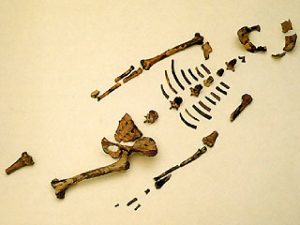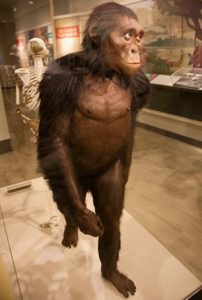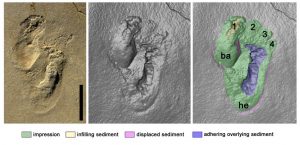Not long ago (My Post of June 10th 2017) I complained that important finds of human and hominid fossils are too often reported in the press as ‘Shocking new Discoveries that will rewrite Human Pre-History’. Well I may have to eat my words this time because the recent unearthing at Trachilos on the island of Crete of 5.7 million year old fossil footprints could indeed rewrite human pre-history.
The footprints of human beings and the human like, upright walking apes called hominids are different from any other kind of creature. First of all like all of the primates we have no claws and our inner toes are substantially larger than the others, hence the ‘big toe’. Unlike our cousins the apes however our big toe does not stick out at a right angle the way our thumb does. These characteristics combine to make hominid footprints truly distinctive.
For the past 40 years the earliest known fossil hominid footprints were those discovered by Mary Leakey at lake Laetoli in Kenya, which were dated to 3.66 million years ago. These footprints are thought to have been made by a member of the species Australopithecus afarensis, the same species as the famous fossil Lucy. The images below show the fossils of Lucy and a reconstruction of what she may have looked like.


The footprints at Laetoli, along with fossil remains like Lucy, are some of the key evidence for the ‘East African Cradle’ model of human evolution. The basic idea is that about 4.5 million years ago our ancestors moved from the jungle onto the East African grasslands. Adapting to their new environment by 3.5 million years ago our ancestors had become fully bi-pedal like Lucy and the makers of the Laetoli footprints. All subsequent hominid species, including us, are descended from those early walkers.
The footprints discovered on Crete could require a significant extension of if not an almost complete rewrite of that theory. Not only are they two million years older than the prints at Laetoli but they are on a different continent!
The Trachilos footprints were discovered and have been studied by a group of paleo-anthropologists led by Matthew Robert Bennett of the University of Bournemouth in the UK and Per Ahlberg of the University of Uppsala in Sweden. The footprints, several of which are shown in the images below, have been dated very precisely by the presence of fossil shells of marine microorganisms called foraminifera. The shells of these tiny single celled creatures evolved very quickly making foraminifera very useful fossils for dating the sediments in which they’re found.

Doctors Bennett and Ahlberg point out that at the time the footprints were made the sea level in the Mediterranean was much lower. Back then Crete was not an island but rather a part of the Greek mainland. In fact the size and depth of the Mediterranean Sea has varied greatly over the past 10 million years and it is quite possible that groups of early or even pre-hominid apes may have wandered around the eastern Mediterranean basin with one of them making the footprints on Crete.
Of course it is also possible that we have simply misidentified the footprints. Precise identification of any fossil is a hard thing to do and trace fossils, such as footprints or burrows, can be the hardest of all.
One thing is certain; if Greece or Sicily or east cost of the Mediterranean was inhabited by groups of early hominids then there are more fossils out there to be found. More evidence that could lead to a more complete picture of human evolution. Perhaps an ‘East Africa and Eastern Mediterranean Cradle’ model. If you’d like to read more about the footprints discovered at Trachilos Crete click on the link below.
